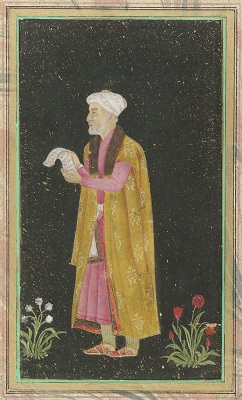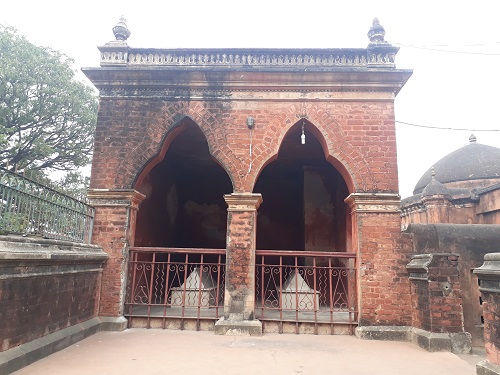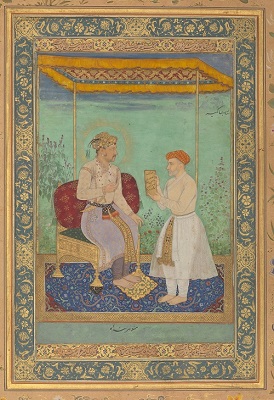Opening Note: This is the second of a five-part story. It is about a family of nobles that seem to turn up repeatedly while studying Mughal history, making themselves almost indispensable across several generations of rulers, beginning with Akbar and going on till Aurangzeb’s successors, encompassing a period of over 130 years. In the first part (link at the bottom), we explored the tomb of Parwar Khanum at Badaun, Uttar Pradesh. In this story, we cut to the beginnings of this family in India – to the point where Parwar’s grandfather comes from Persia.
The refugee
Mirza Ghiyas Beg was born in Tehran in the mid-16th century CE. The son of statesman and poet, Khvajeh Mohammad Sharif, Beg would probably have had a privileged upbringing. He was married to Asmat Begum, a daughter of the Aqa Mulla clan, an illustrious family of the state. Around 1576, after his father’s death, Ghiyas Beg is said to have lost favour in Persia. This reversal in fortune caused him to try and seek his future elsewhere and he began a journey east, with his family.

Portrait of Mirza Ghiyas Beg (Pic source: Wikipedia)
What perhaps drew him were accounts of the growing prosperity of the Mughal court, where Emperor Akbar had been ensconced for nearly two decades leading to a stable polity. Another factor that may have influenced his choice of destination was a cousin of his as well as his wife’s uncle were already in the employ of the Mughal administrative system.
Fortune ebbs and flows
Accounts hold that on this fateful eastward journey the family is attacked by a group of robbers and deprived of their possessions. Left with two mules, Beg had to take care of a pregnant wife, two sons and a daughter. They took turns riding these animals and make their way to Qandahar, where Asmat Begum gave birth to a second daughter, in 1577. Their position was precarious, and some stories say that the family even abandoned the extra mouth that had to be fed.
Around the same time, they were helped by a merchant, Malik Masud, who also happened to be a nobleman in the Mughal court. With his help, Ghiyas Beg found work as an official in the Mughal imperial system. It was the beginning of a new dawn for the family – one that lasted several generations. In some ways, the new child was seen as a blessing and named Mehr-un-Nissa or ‘Sun among Women’. Her story forms the acme of this family’s standing and will be outlined here in the next part of this family’s narrative.
Ghiyas Beg became the diwan (treasurer) of Kabul. Whether it is his ability or a shade of cronyism or a mix of both, Beg rose in rank over time. There were difficult moments too – at one point he was accused of embezzlement of funds leading to a decrease in rank, remaining out of favour for some time. One of his sons was executed for being part of a plot against Emperor Jahangir. However, these moments passed and the former refugee went on to become one of the empire’s most people, going on to be titled ‘I’timaduddawla’ (Pillar of the state).
The power of alliances
While Ghiyas Beg’s sons also joined imperial service, the family adroitly uses marriage alliances to strengthen their position and work towards an assured future. A son, Abul Hasan – later titled Asaf Khan – is married to the daughter of another eminent noble Khwaja Ghias-ud-din of Qazvin. A daughter is married to Sadiq Khan, who goes on to become Mir Bakshi in 1622, Governor of Punjab in 1623. Sadiq Khan is also of Persian stock and is said to have been Beg’s nephew.
But it is the child that Beg and family came close to abandoning that proved to be their trump card. Initially, Mehr-un-Nissa was married to a nobleman called Ali Quli Khan Istalju, better known as ‘Sher Afghan’. After his death (murder) in Bengal, she returned to the capital where, in 1611, she caught the eye of Emperor Jahangir.

The tomb of Istalju, or Sher Afghan, in Bengal
Their subsequent marriage saw a meteoric rise in the status of Ghiyas Beg. His mansab increased rapidly and he was also titled Wazir.

Emperor Jahangir with Mirza Ghiyas Beg, the I’timaduddawla (Pic source: Wikipedia)
Between Ghiyas Beg, Mehr-un-Nissa – later the empress Nur Jahan – and his son Abul Hasan (Asaf Khan), the family was perhaps at its strongest in the period post 1611. Amidst this were important marital alliances sought by Mehr-un-Nissa and Abul Hasan for their respective daughters, pitting brother against sister in the Mughal game of thrones for succession. More about this in later chapters on this family.
The passing
On 10th October 1621, Asmat Begum passed away in Agra. From here, we quote the Jahangir-nama (translation), to bring out what transpires in the words of the Emperor himself:
“No husband has ever had the affection and attachment for his spouse that I’timaduddawla had for her. One can therefore imagine what befell the poor grief-stricken old man….From the day his spouse passed away he no longer took care of himself and wasted away day by day. Although externally he took great pains in administering the empire and tending to fiscal affairs, and he wouldn’t leave his post, he suffered inwardly from loneliness until he died three months and twenty days later.”
Ghiyas Beg, one time refugee with two mules, and by then one of the most powerful men in the Mughal system, himself died in 1622, near Kangra. Here is what the Jahangir-nama (translation) says of his final moments:
“Because I’timaduddawla was ill, I left him in the camp and stationed Sadiq Khan the mirbakhshi to watch over him and guard the camp. The next day news arrived that I’timaduddawla’s condition had worsened and there was no hope. Both because of Nurjahan Begam’s distress and because of the affection I had for him, 1 had to turn back to the camp. I went in to see him toward the end of the day. He was hallucinating and drifting in and out of consciousness…”
The Jahangir-nama (translation), in tribute to Ghiyas Beg:
“He was not only a perfectly intelligent vizier but also a kind and wise companion. By the reckoning of my two eyes he is less than one body, but by the reckoning of wisdom he is more than thousands. Despite the fact that the weight of the administration of such an empire was on his shoulders, and it is not within human capability that one keep everyone happy in matters of income and disbursement, no one ever went before I’timaduddawla on business and came away with a grudge. He maintained loyalty to his sovereign and made the poor happy and hopeful.”
Asmat Begum and Ghiyas Beg were buried in a magnificent tomb built for them by their daughter Mehr-un-Nissa (Nur Jahan) in Agra.

The ornate tomb of Mirza Ghiyas Beg, the I’timaduddawla, at Agra

The tomb built on the banks of the Yamuna, seen from its river pavilion
The next part of this story about Mughal nobility’s first family is that of Nur Jahan.
Link to part I: https://hiddenheritage.in/index.php/2023/06/24/first-family-of-mughal-nobility-1-quest-starts-in-badaun/





